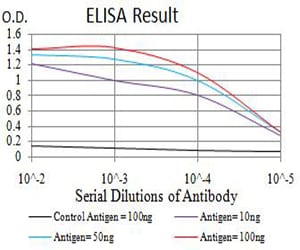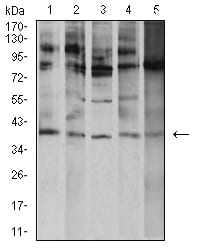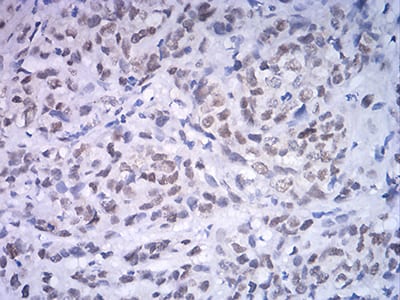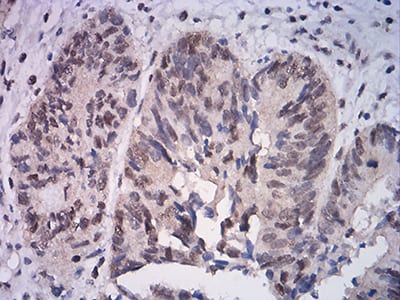



| WB | 咨询技术 | Human,Mouse,Rat |
| IF | 1/20-1/50 | Human,Mouse,Rat |
| IHC | IHC:1/100-1/200;IHF:1/50-1/200 | Human,Mouse,Rat |
| ICC | 1/50-1/200 | Human,Mouse,Rat |
| FCM | 1/20-1/100 | Human,Mouse,Rat |
| Elisa | 咨询技术 | Human,Mouse,Rat |
| Aliases | CREB2; TXREB; CREB-2; TAXREB67 |
| Entrez GeneID | 468 |
| clone | 2A6F12 |
| WB Predicted band size | 38.6kDa |
| Host/Isotype | Mouse IgG1 |
| Antibody Type | Primary antibody |
| Storage | Store at 4°C short term. Aliquot and store at -20°C long term. Avoid freeze/thaw cycles. |
| Species Reactivity | Human |
| Immunogen | Purified recombinant fragment of human ATF4 (AA: 212-351) expressed in E. Coli. |
| Formulation | Purified antibody in PBS with 0.05% sodium azide |
+ +
以下是关于NAT10抗体的参考文献示例(注:部分信息为示例性整理,建议通过学术数据库核实具体文献):
---
1. **文献名称**: *NAT10-mediated ac4C modification promotes mRNA translation and tumorigenesis*
**作者**: Arango, D. et al.
**摘要**: 该研究揭示了NAT10通过催化mRNA上的ac4C修饰增强翻译效率,促进癌细胞增殖。研究中使用了特异性NAT10抗体进行RNA免疫沉淀(RIP)和蛋白质印迹(Western blot),证实其在结直肠癌中的关键作用。
2. **文献名称**: *NAT10 regulates MYC expression through ac4C modification in hepatocellular carcinoma*
**作者**: Liu, H. et al.
**摘要**: 本研究通过免疫组化(IHC)和基因沉默实验,证明NAT10在肝癌中高表达,并通过ac4C修饰调控致癌基因MYC的稳定性。实验采用商业化NAT10抗体(如Abcam产品)进行组织样本检测。
3. **文献名称**: *Targeting NAT10 inhibits cancer metastasis via suppression of EMT pathways*
**作者**: Wang, Y. et al.
**摘要**: 文章利用NAT10抗体进行ChIP-seq分析,发现其与上皮间质转化(EMT)相关基因启动子结合,促进肿瘤转移。抑制NAT10可显著降低乳腺癌小鼠模型的转移能力。
4. **文献名称**: *Development and validation of a NAT10-specific monoclonal antibody for ac4C detection*
**作者**: Zhang, Q. et al.
**摘要**: 该文献报道了一种新型NAT10单克隆抗体的开发与验证,证明其特异性识别ac4C修饰的RNA,并应用于临床样本的分子诊断研究。
---
建议通过 **PubMed** 或 **Google Scholar** 检索具体文献,结合关键词如“NAT10 antibody”、“ac4C”和“cancer”获取全文。
The NAT10 antibody is a crucial tool for studying the function and regulation of N-acetyltransferase 10 (NAT10), an enzyme belonging to the GNAT (Gcn5-related N-acetyltransferase) superfamily. NAT10 catalyzes N4-acetylcytidine (ac4C) modification in RNA, a process implicated in mRNA stability, translation efficiency, and cellular stress responses. Initially identified as a nuclear protein localized to nucleoli, NAT10 plays roles in ribosome biogenesis, cell cycle progression, and DNA damage repair. Dysregulation of NAT10 has been linked to diseases, including cancers, where its overexpression correlates with tumor progression and poor prognosis, as well as age-related disorders like progeria.
The NAT10 antibody enables researchers to detect and quantify NAT10 protein levels via techniques like Western blotting, immunofluorescence, and immunohistochemistry. It is essential for investigating NAT10's spatial-temporal expression, interactions with RNA or protein partners, and its regulatory mechanisms. Validating antibody specificity—often through knockout controls—is critical due to potential cross-reactivity with other acetyltransferases. Recent studies highlight NAT10's therapeutic potential; inhibitors targeting its acetyltransferase activity are being explored for cancer and aging-related therapies. As interest in epitranscriptomic modifications grows, the NAT10 antibody remains vital for unraveling the biological and pathological significance of ac4C and NAT10-mediated pathways.
×